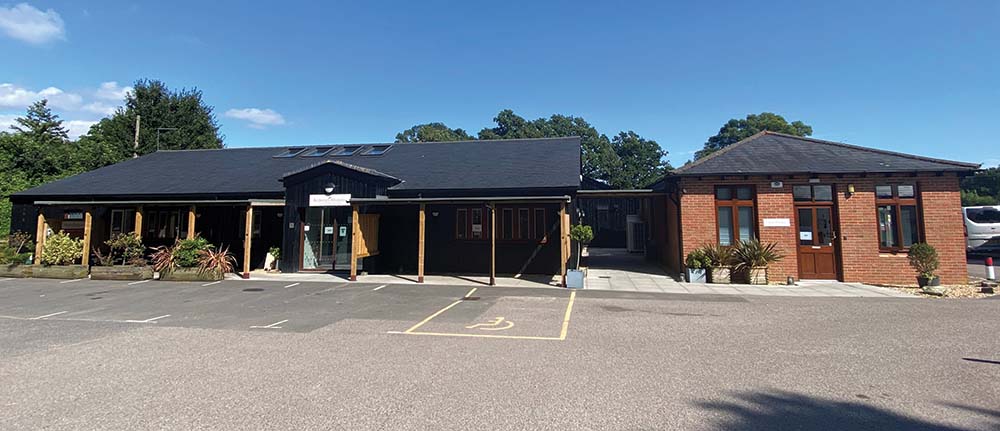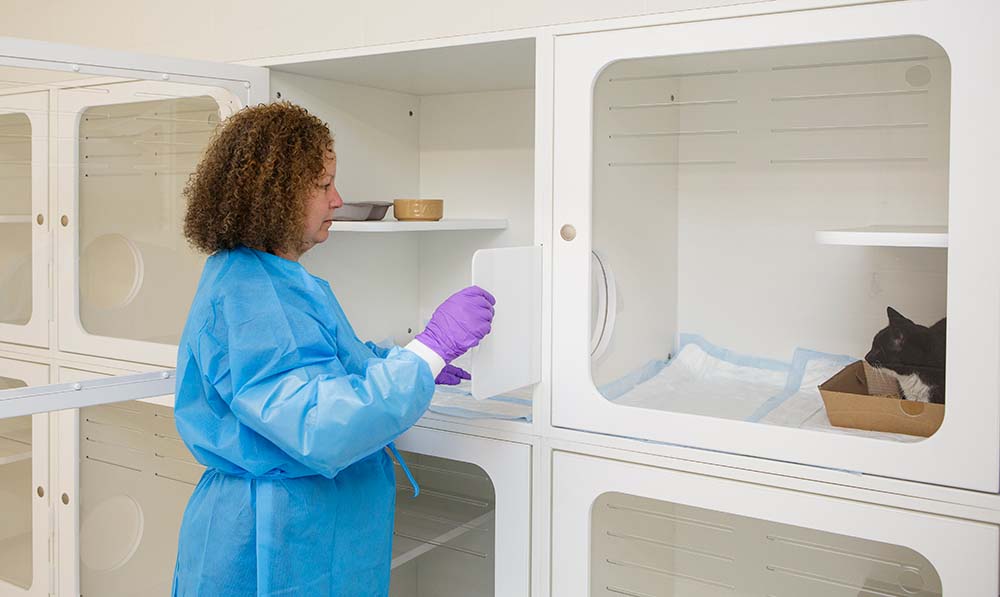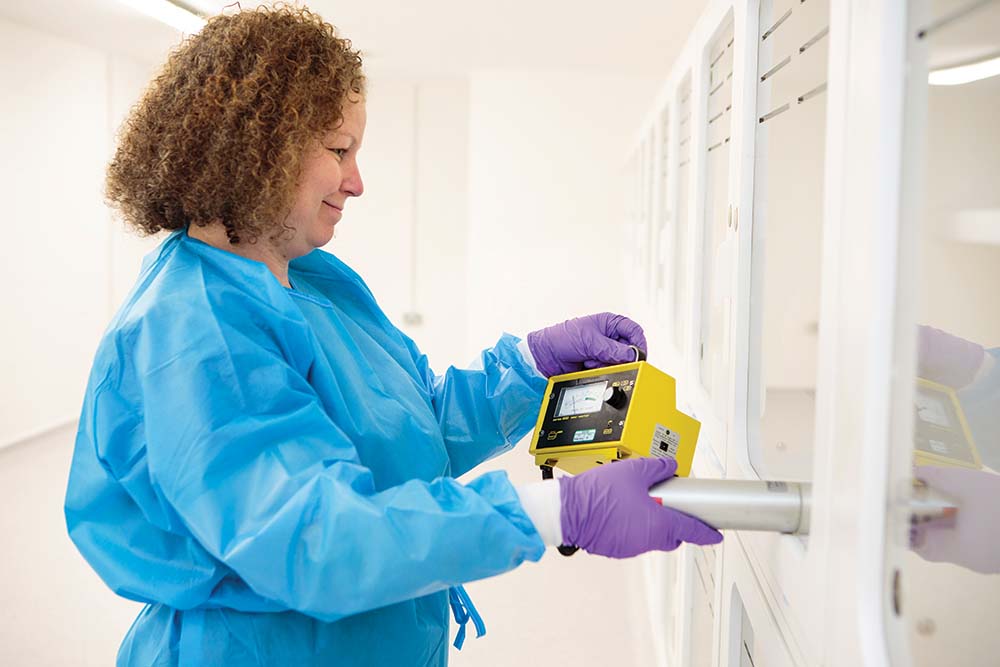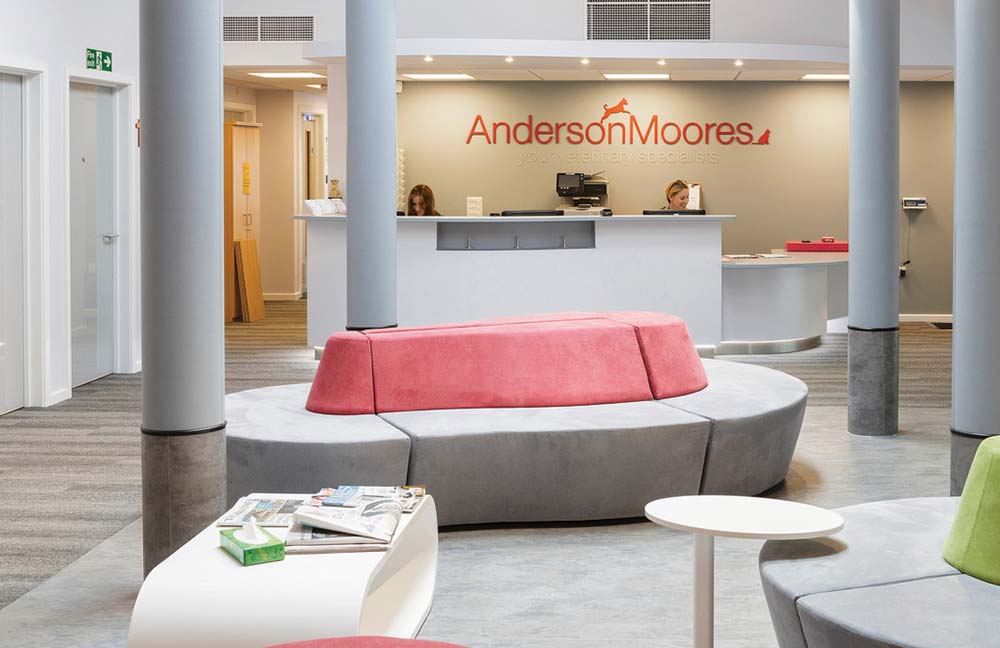3 Sept 2021
Anderson Moores was established in August 2006, and since then its story has been one of spectacular growth and development. And despite the impact of coronavirus and two recent changes of ownership, its rapid rise has continued unabated, as <em>VBJ</em> discovered when we caught up with director David Walker…

A bird’s eye view of Anderson Moores Veterinary Specialists. Image © Anderson Moores Veterinary Specialists

Staff: full-time vets 55 • registered veterinary nurses 64 • practice administration and support staff 119
When Davina Anderson and Kit Sturgess first opened the doors of their referral business in deepest Hampshire exactly 15 years ago, the practice offered a limited repertoire.
Soft tissue surgery, orthopaedics and medicine were the specialist disciplines at its inception, and those were the skills on which it began to build its reputation. Dial forward a decade-and-a-half and the practice has become a true multidisciplinary powerhouse, serving a broad range of clients across the south of England and beyond.
It is a narrative mirrored by referral practices across the UK, where a seemingly never-ending demand for advanced veterinary services has seen the referral market boom – and it’s a boom that shows no sign of slowing down.
Anderson Moores started life as just three clinicians and a handful of support staff, but now employs more than 200 people, including 55 vets – 25 of them specialists – working across an ever-increasing range of referral disciplines.
The practice may have been built on the disciplines of orthopaedics, soft tissue and medicine, but during the past decade-and-a-half the offering has ballooned, with neurology and neurosurgery, cardiology, dentistry, anaesthesiology, oncology, diagnostic imaging, dermatology, physiotherapy, pain management and critical care all now available, while a feline radioactive iodine clinic has also come online in the past few years.
It’s all a far cry from the practice’s smaller initial offering, as David Walker explained: “The practice was initially set up by a soft tissue surgeon called Davina Anderson and her husband, along with Kit Sturgess and his wife.
“It initially started as a five-person practice with three clinicians and two nurses, and then it has grown year-on-year since then, with Andy Moores joining in 2009.
“I joined in 2011, which was the time that Kit Sturgess stepped away, and the ownership team at that point was Davina Anderson and her husband, Andy Moores and myself. We’re now up to 210 team members, which is quite astonishing growth over the time period.
“The local market has changed a lot, of course, during that time, as it has across the whole of the UK. Initially, when Davina and Kit set it up I believe they were the only multidiscipline referral practice in this area, and actually one of a very small number of non-university referral practices. That’s completely changed now; there are so many referral practices across the country, but all seemingly have a high demand for their services.
“Nobody knows for sure why that is, and it’s likely to be multifactorial and perhaps related to things like corporatisation of the market, and increased awareness among clients and vets of what can be offered in a referral setting.”
All that explosive growth in the market has meant Anderson Moores has had to grow with it; initially based out of just one building at its main Bunstead Barns site in Hursley near Winchester, the referral hospital now fills four buildings, with a fifth due to be occupied in the second quarter of next year.
Two additional sites nearby house the admin and HR teams, and extra storage space, as well as the hyperthyroid clinic that David describes as “possibly the best facility in the UK in terms of design and space available for the cats”.


An independent practice for the first 10 years of its life, in 2016 the ownership team decided to sell a significant share to Pets at Home, which at the time was looking to build its own specialist referral division.
It was a decision arrived at only after much soul-searching among the existing partners, who only decided to go all in once it had become clear progress may be hampered without the investment a change of owners would bring.
David added: “It was something we probably started talking about around 2014, when the market was starting to become corporatised and we were starting to be approached. Initially, our viewpoint was, no, we absolutely want to stay independent.
“But as time advanced and we continued to grow, we could see the level of investment that was going to be required to do the things that we wanted to do. We had all taken on a fair bit of risk and I don’t wish to speak for my ex-partners, but certainly for me individually, I just wasn’t sure I was comfortable to take on that increasing level of risk and partly felt that we would start to hold the practice back.
“We needed hundreds of thousands of pounds for investment in buildings and improvement in existing kit, and we felt that having the support of a corporate partner was going to help us to do that and, ultimately, I felt that was really the best thing for the practice and all of the team members here moving forward.”
However, after the upheaval of moving from an independent into corporate hands, less than five years later more change arrived when Pets at Home announced it would be selling its five referral practices to the Linnaeus group.
The announcement saw Anderson Moores, Dick White Referrals, Northwest Veterinary Specialists, Eye Vet, Veterinary Specialists Scotland and almost 680 staff join the Mars-owned company in early 2021.
At a stroke, Linnaeus acquired some of the most highly respected operations in the UK – and for the team at Anderson Moores, the move has already delivered benefits.
David said: “Linnaeus have really invested heavily in that quality piece. In my view they are leading the way in CPD delivery – both clinical and non-clinical – and are leading the corporate market in VetSafe, clinical research and career development opportunities for the team, including central investment in support for group interns, residents and student nurses – they’re just doing everything properly to retain and attract the very best people.
“But of course it’s always challenging moving from one type of business to another. It wasn’t necessarily an easy transition going from independent to Pets at Home, and you have to be aligned with its procedures, processes, policies, and then you do the same thing with Linnaeus; it was a tough first four to six months, but there was a great integration team to support us.
“They’re incredibly good at connecting referral practices together and want to do whatever they can to support their teams.
“Linnaeus offer virtual away days where all clinicians are connecting, senior nursing teams are connecting with other senior nurses at other practices and this connectivity runs at every single level to ensure the sharing of best practice. Practice managers engage with other practice managers to learn more about the function of reception teams, for example, and how we can improve the referring vet and client experience at every step of their journey.
“Ultimately, as a business develops and grows, you make some mistakes. And the beauty of being in a group like Linnaeus with lots of practices is that people have made those mistakes before because they’ve tried something and maybe it hasn’t worked, so rather than making those same mistakes, we can look and say, ‘how did that work for you?’”
Like all veterinary practices large and small, Anderson Moores has been challenged on an unprecedented scale by the emergence of coronavirus. Almost a year-and-a-half after the virus first hit, the hospital is still not allowing clients into buildings as – with a “pingdemic” in full swing – the management team is determined to do what it can to protect staff and keep the show on the road.
David added: “Coronavirus was obviously tough, especially during lockdown one when we switched to emergency-only working. Making sure our people were safe was our top priority here and we of course wanted to make sure we could still service our referring vets out there in primary care practice; we wanted to support them and their clients, and make sure pets were still getting an exceptional standard of care.
“Clients are still not back in the buildings here. We developed a nice set-up, with clients reporting to our reception team at a large bank of windows on our reception building that we’ve built some stylish-looking wooden shelters over.
“Clients come up to the window to register their arrival, they then return to their car and our clinicians are doing the consultation over the phone to minimise face-to-face interaction. Then we will go and collect their pet, bring it into the clinic and do the physical examination, and then have a second conversation with the client to discuss the options.
“So, those processes are working very well and we just felt that at the moment, while case numbers are still reasonably high out there in the general population, that it was sensible to stick with these policies, to keep our team safe and to keep our clients safe.
“I think clients understand, as long as you put the narrative around it. We tell clients before they arrive what their experience is going to be. So our team knows that they’re prepared for what the experience will look like.”

Despite ongoing restrictions on the way the team at Anderson Moores is working, business is excellent, with the hospital seeing a big uplift in case numbers when compared to pre-COVID levels.
Many other practices are experiencing the same increased demand for services in both primary and referral settings, and there are plenty of reasons flying around as to why this may be the case, as David explained.
He added: “I think we’ve experienced here what most of the profession has experienced, which is a real uplift in case numbers. We don’t know for certain why that’s been, but there are lots of potential theories; delayed work was one factor initially, although we’ve of course well caught up with that now and we are still seeing the high case volumes.
“Part of it may be that in the primary care space, recruitment has been challenging and there are perhaps fewer vets in some practices, and they are understandably struggling to manage the workload. With smaller teams, any coronavirus absence will be felt more acutely and perhaps patients are being referred earlier in the course of their investigation or referred when they might not have been historically.
“Brexit has perhaps had an impact, too, and maybe primary care vet numbers are lower because of that. It may also be that the pandemic has led some people to re-evaluate their life and they have stepped away from the profession, are having a break or are part-time working. There are a lot of factors at work here.”
At present the hospital has a separate reception building, called the Mews, with cat and dog waiting areas, and eight consulting rooms, while there are also two main clinical buildings – one called the Granary and the other dubbed the Bothy.

David added: “The two clinical buildings are where all the fantastic patient care happens. As you’d expect, we have some incredible kit, and the combination of that and the amazing people we have leads to incredible diagnostic and therapeutic work.
“All of our wards are built into these two buildings, we’ve also got a dedicated oncology facility and physiotherapy room as well, and then our fourth building on this site is the called the Dairy.
“That is primarily office space, but we’ve also got our sterilising space, on-site lab and a meeting room. So they are the four buildings we currently occupy on this site, and then there’s a fifth building, which is currently used by a specialist human dentist. He will be moving out of that building around the start of the second quarter of 2022 and we will be taking over that space.
“That will give us some more kennelling capacity and a little bit more office space, and improve our physiotherapy facilities. We’re also going to have an extra theatre and an extra procedure room, so there is lots of great stuff happening with that expansion.”
There has also been more than £400,000 of investment in new kit since Linnaeus took over the operation. This cash injection has seen a new fluoroscope, 64-slice CT purchase, new echo machine and new ultrasound machine added, while ongoing significant improvements have been made to the general infrastructure of the practice, too. This includes complete resurfacing of some of the roadways to the practice and the creation of a woodland walk area adjacent to the main practice site.
The latter project fits in with plans to go for bronze Investors in the Environment accreditation with the support of Ellie West, Linnaeus’s environmental sustainability lead.
On the clinical side, as well as the hyperthyroid clinic offering gold-standard radioactive iodine treatment, Anderson Moores has also just added emergency and critical care to its offering, and has expanded its dermatology service.
But in a field of veterinary medicine where recruitment has always been a challenge and against the backdrop of a sector-wide recruitment crisis, adding new disciplines is something that must be done with a great deal of care and consideration.
David said: “Adding a new discipline is always tough – it’s not just about recruiting the specialist(s), it’s about making sure that you approach the service in the right way and ensure it gels seamlessly with the current operations.
“We added dentistry last year with Matthew Oxford joining us and we expanded our dermatology service last month – we’ve had dermatology one day a week for a long time and now we have gone up to four days a week.
“And our most recent addition is emergency and critical care. In terms of recruitment, I think the situation changes month to month in terms of who is available. I suspect it’s the same problem in many professions or any space, and it’s variable.
“I also think with so many referral centres it’s a really competitive market, and specialists and nurses are a scarce resource.
“When a specialist comes on to the market, you can pretty much guarantee that they are going to be receiving multiple offers. I think one of the advantages we offer is that we’re multidisciplinary and many clinicians want to work in that environment.
“We’ve got strength and depth in almost all of our teams, and I think that also attracts specialists. If I think back to being a new specialist, I wouldn’t have wanted to necessarily step into a practice where I was starting a service or when there was only one other team member – it’s nice to come in and feel part of a team.”
One of the ways to tackle the recruitment problem is, of course, to “grow your own” – something Anderson Moores, and David himself, takes very seriously. A shortage of GP vets is also mirrored in the referral sector and for David, the only way this can be tackled is by making sure interns and residents get the support they need, in every discipline.
He added: “It’s no good being sat here with a big team of specialists not training new specialists, because that model is going to end very quickly. So, across pretty much all of our disciplines, we have incredible resident teams; so we have eight medicine residents, three surgery residents, two anaesthesia residents and an imaging resident.
“You’ve got to train the next generation, otherwise the clinicians will not be available in the future. The advantage of being part of a large group is that different practices can take different approaches, but I personally love being surrounded by the enthusiasm and energy of residents. They keep you on your toes every day.”
But despite this approach, Anderson Moores – like most referral centres – has, at times, struggled when it comes to imaging specialists. It is in the fortunate position of having five imaging specialists currently, but with so many imagers being enticed away to work remotely, David is concerned about not having enough boots on the ground to train the next generation.
He added: “Working for remote tele-imaging companies works well for some people, and suits their lifestyle desires and work ambitions; however, perhaps there is a model for a more hybrid role, where they are spending some time in the clinic as well. Currently, you cannot remotely train an imaging resident – they need hands-on experience of ultrasound and organ sampling, for example.
“So imaging is a particular concern for me because so many specialists are reporting remotely. Where’s the next generation going to come from? Are we training enough and is there going to have to be a shift change in the way referral centres approach their imaging needs?
“I suspect some of the imagers working remotely do want to spend some time in a clinic; they perhaps just don’t want to spend four or five days doing it. So maybe the long-term model is two days in the clinic, two or three days working from home – that would allow continued training of the next generation.
“But I am sure as a profession we can overcome all of these issues and as a hospital we just want to continue to work together to deliver the best for our team, our referring vets, our clients and most of all their pets.”